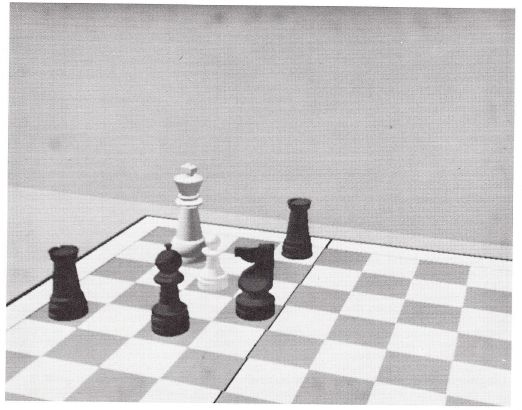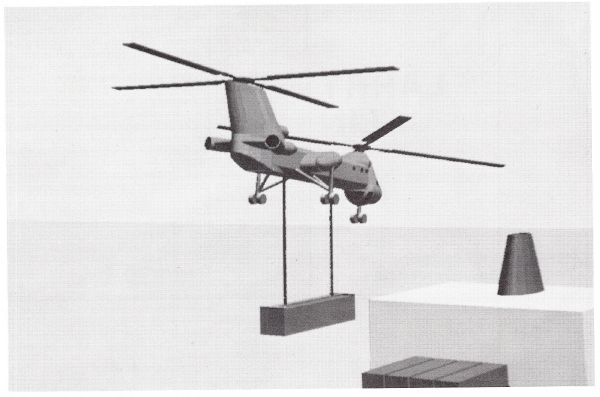LARRY ELIN
SYNTHAVISION: SERENDIPITY FROM THE NUCLEAR AGE
It is not at all an unusual phenomenon that, in the course of scientific inquiry, one discovery begets another and subsequent breakthroughs produce an unintended chain of pleasant surprises. So it was that physicists studying the effects of radiation on domestic and military structures developed an exciting and unique method for producing computer generated animation.
The new animation technique is called Synthavision and is marketed commercially by Computer Visuals, Inc., of Elmsford, New York. Using the process, dimensional, shaded objects can be made to perform a countless variety of complicated movements and captured on film. Amazingly, the objects don't have to exist. The need for art work, photographs or prototypes has also been eliminated, since Synthavision enables the animator to produce his 'actors' within the software of the computer mathematically
This incredible attribute is an offshoot from the work which inspired the development of Synthavision in the first place. Scientists at Mathematical Applications Group, Inc., Computer Visuals parent company, were conducting experiments in which whole environments were mathematically described to a computer (an IBM 360/65). These mathematical models were then 'exposed' to a hypothetical dose of radiation. The program then in use diagnosed the effects of the radiation on the objects in the environment—how much reflected off, detracted within or penetrated. Although neither the environment nor the radiation existed, the findings were accurate and applicable to real life.

Because radiation and light rays have many of the same characteristics, the scientists, led by Dr. Phillip Mittelman and Robert Goldstein, theorized that mock situations such as these could be programmed exposing the objects to light rays instead of radiation. All of the light would, of course, reflect off the solid objects in the program. The program could include a command to direct the reflected light to a single point which would act as an 'eye,' or camera. The light reflected off the objects and to the camera would create an image of the objects. Years of research followed, and the result is Synthavision, complete with mathematically described objects, camera and light source—all of the elements necessary to create a film studio situation in the memory of the computer.

The input for this child of the nuclear age includes descriptions of the objects, or 'actors' in the film, the location and characteristics of a camera (focal length and size of image plane), the direction from which the light is coming and a set of instructions called 'Director's Language,' which tell the computer how to treat the objects (animate the actors) in the film.
These variables are first determined by the animator, and then key punched in a specified, very easy to use, format designed expressly for Synthavision. Based on the information, the IBM 360/65 computer makes extensive calculations to determine what the object looks like in each frame of the movie. It outputs, in digital form, the frame by frame mathematical descriptions of the objects on magnetic tape. The tape is then mounted on a minicomputer, whose function is to read the tape and output the information piecemeal—one frame at a time. The electronics of a graphics display machine converts the digital information to analog form. This signal is then displayed on a Cathode Ray Tube (CRT), from which it is photographed by conventional animation cameras. It may sound like a long, drawn out process, but it is really quite fast, although by no means real time. A computer animator could produce a one minute film in about 1/3 the time required of a hand animator.
"How," you may ask, "does one describe an object to the computer?"
It is really quite simple. Synthavision incorporates a technique known as combinatorial geometry, whereby whole, voluminous shapes such as boxes, spheres and cones are added or subtracted to form more complex shapes. The equations for these shapes, and others, have already been programmed into the computer's memory. The animator need only call for them, designate their location and size and inform the computer which shapes are solid and which are to be invisible—a trait necessary to subtract one volume from another. Almost any known or imagined object can be described to the computer this way. The animator 'models' his objects in much the same way as a sculptor might use old pipes and scraps of wood to create a work of art. The animator using Synthavision has more flexibility, however, because he can cause his object to move and, in a sense, come to life.
Movement is given to the actors by key punching commands to move, turn or scale the objects in a certain number of frames. The camera can also be made to move or rotate. A typical command might be to move the object in 120 frames (five seconds) from point A to point B, while simultaneously rotating the object about point C. The computer calculates what the object looks like in each of those frames and writes the information on magnetic tape.
When the frames are viewed sequentially, the illusion of movement has been created.
If there is one very obvious advantage of the Synthavision process, it is the scientifically accurate shading and perspective maintained by the objects regardless of how they are moved or turned. They appear to be real, though somehow cartoonish in nature. Indeed they should since, as far as the computer is concerned, they are real. The effect of reality is created in the software by assigning a gray level to the points on the surface of the described object. The gray level is determined by the orientation of the point with respect to the camera and the light source. The more acute the angle, the brighter that point will be. A sphere, for example, will be brightest where its exposure to the light source is most direct, and will gradually become darker as its surface curves away from direct exposure.
There are other very attractive attributes of Synthavision. It is very fast. An animator, in order to produce one minute of film, would have to draw 1440 cels or pictures, each a little different. There are short cuts which are commonly used to reduce this number to some extent, but the fact remains that one minute of film requires long hours at the drawing stand. Each drawing would then have to be inked (outlined) and opaqued (colored) and finally filmed. All of these steps are done manually, for the most part, and require a variety of skills and personnel. A computer animator need only to describe the picture elements once and then command the computer to produce the necessary pictures. The computer also 'opaques' and performs the filming. It accomplishes all of these tasks at great speed, freeing the animator for creative rather than manual endeavors.
The tremendous flexibility, expediency, and accuracy of Synthavision testifies to the potential for the computer in the animation and Graphic Arts fields. When you consider that Synthavision is actually in a very early stage of development, the future appears even more favorable—both for Synthavision (and whatever follows), and for Computer Graphics in general.
Elmsford, New York
October 1975

Return to Table of Contents | Previous Section | Next Section

